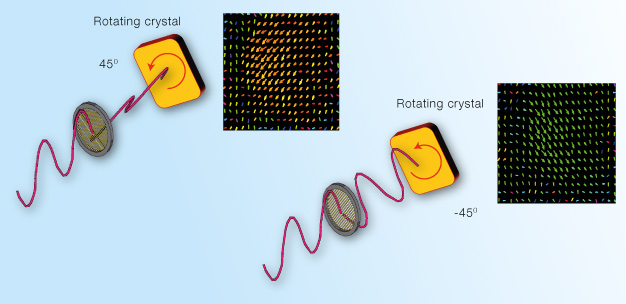An innovative spinning-crystal technique allows researchers to peer inside objects in just milliseconds using terahertz light
Published online 6 March 2015

Researchers have used light, naturally polarized by a rotating crystal, to generate two-dimensional, real-time snapshots of terahertz electric-field vectors (colored arrows in panels on right) for high-tech, subsurface imaging applications.
© 2015 Shinichi Watanabe, Keio University
A new imaging device developed at Keio University1 dramatically shortens the time needed to perform 'terahertz electric-field vector sensing' ― a technique of interest to art historians and materials scientists alike for examining molecular-scale surface properties using low-power radiation. The high-speed optical probing characteristics of this device may find use in real-time manufacturing monitors or hidden object detectors at security checkpoints.
Situated between the infrared and microwave regions of the electromagnetic spectrum, terahertz radiation has unique characteristics ideal for high-tech applications. For example, it has an intrinsically low energy, making it is less damaging than X-rays but penetrating enough to see through opaque materials such as plastics or paper. However, it has proved challenging to find ways to controllably generate terahertz light and detect how the amplitude, phase, and polarization of these beams change after interacting with a sample ― data that can precisely identify material composition and properties.
Since 2012, Shinichi Watanabe and his team from Keio University's Department of Physics have been working to advance this experimental technology through 'terahertz time-domain spectroscopy'. In this approach, terahertz light is mixed with pulses of short-wavelength, near-infrared light inside a special electro-optic crystal before hitting the target. By varying the timing of the near-infrared light pulses, the researchers can monitor the amplitudes and phases of the terahertz waves on a video screen, similar to an oscilloscope.
Now, the Keio researchers have improved upon their concept by developing a way to probe time-dependent changes to the terahertz beam polarization. Watanabe explains that traditional devices for tracking how light behaves in different planes, such as wire-grid polarizers, limit the bandwidth of collected data. Fortunately, the team found a superior solution ― the electro-optic crystal they used to mix terahertz and near-infrared light pulses had a natural symmetry that could detect polarization changes with extreme precision.
By shining terahertz light onto a mechanically spinning electro-optic crystal, the researchers used the polarized beams and high-speed cameras to capture the terahertz electric-field vectors (see image). These images provide real-time information of the magnitude and spatial distributions of the terahertz radiation passing through a substance ― data that Watanabe says can improve understanding of materials such as birefringent polymer optical components and light-harvesting biomolecules.
"Seeing the amplitude, phases, and polarization of terahertz light gives us triple the amount of possible information," explains Watanabe. "And since the technology utilizes the natural symmetry of the electro-optic nonlinear crystal, it is versatile, precise, and suitable for real-time video mapping of terahertz electric-field vectors."
Reference
- Takai, M., Takeda, M., Sasaki, M., Tachizaki, T., Yasumatsu, N. & Watanabe, S. Video-rate terahertz electric-field vector imaging. Applied Physics Letters 105, 151103 (2014). | article